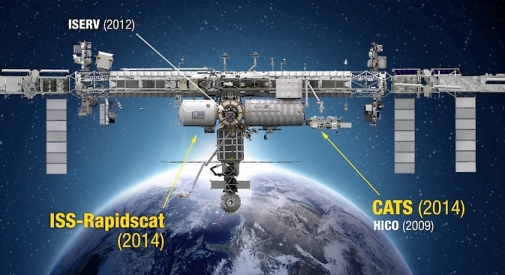
WASHINGTON (PTI): In a move to monitor our planet better, NASA is adding a number of Earth-observing instruments to the International Space Station (ISS) that will increase the leverage of the orbital laboratory's unique vantage point in space.
The launch of a NASA ocean winds sensor to the ISS this month inaugurates a new era of Earth observation, NASA said.
Before the end of the decade, six NASA Earth science instruments will be mounted to the station to help scientists study our changing planet.
The first NASA Earth-observing instrument to be mounted on the exterior of the space station will launch from Cape Canaveral Air Force Station, earlier than September 19.
ISS-RapidScat will monitor ocean winds for climate research, weather predictions and hurricane monitoring from the space station, NASA said.
The second instrument is the Cloud-Aerosol Transport System (CATS), a laser instrument that will measure clouds and the location and distribution of airborne particles such as pollution, mineral dust, smoke, and other particulates in the atmosphere.
CATS will follow ISS-RapidScat on the fifth SpaceX space station resupply flight, planned for December.
"We're seeing the space station come into its own as an Earth-observing platform," said Julie Robinson, chief scientist for the International Space Station Programme at NASA's Johnson Space Centre in Houston.
"It has a different orbit than other Earth remote sensing platforms. It's closer to Earth, and it sees Earth at different times of day with a different schedule. That offers opportunities that complement other Earth-sensing instruments in orbit today," said Robinson.
The space station-based instruments join a fleet of 17 NASA Earth-observing missions currently providing data on the dynamic and complex Earth system.
ISS-RapidScat and CATS follow the February launch of the Global Precipitation Measurement Core Observatory, a joint mission with the Japan Aerospace Exploration Agency.
Most of the agency's free-flying, Earth-observing satellites orbit the planet over the poles at altitudes higher than 400 miles in order to gather data from all parts of the planet.
Although the space station does not pass over Earth's polar regions, its 240-mile-high orbit does offer logistical and scientific advantages.
"With the space station we don't have to build a spacecraft to gather new data - it's already there," said Stephen Volz, associate director of flight programmes in the Earth Science Division at NASA Headquarters in Washington.
Two additional NASA Earth science instruments are scheduled to launch to the station in 2016.
 Previous Article
Previous Article Next Article
Next Article













The Indian Air Force, in its flight trials evaluation report submitted before the Defence Ministry l..
view articleAn insight into the Medium Multi-Role Combat Aircraft competition...
view articleSky enthusiasts can now spot the International Space Station (ISS) commanded by Indian-American astr..
view article